headlamp PONTIAC GRAND AM 1998 Owners Manual
[x] Cancel search | Manufacturer: PONTIAC, Model Year: 1998, Model line: GRAND AM, Model: PONTIAC GRAND AM 1998Pages: 370, PDF Size: 16.11 MB
Page 95 of 370
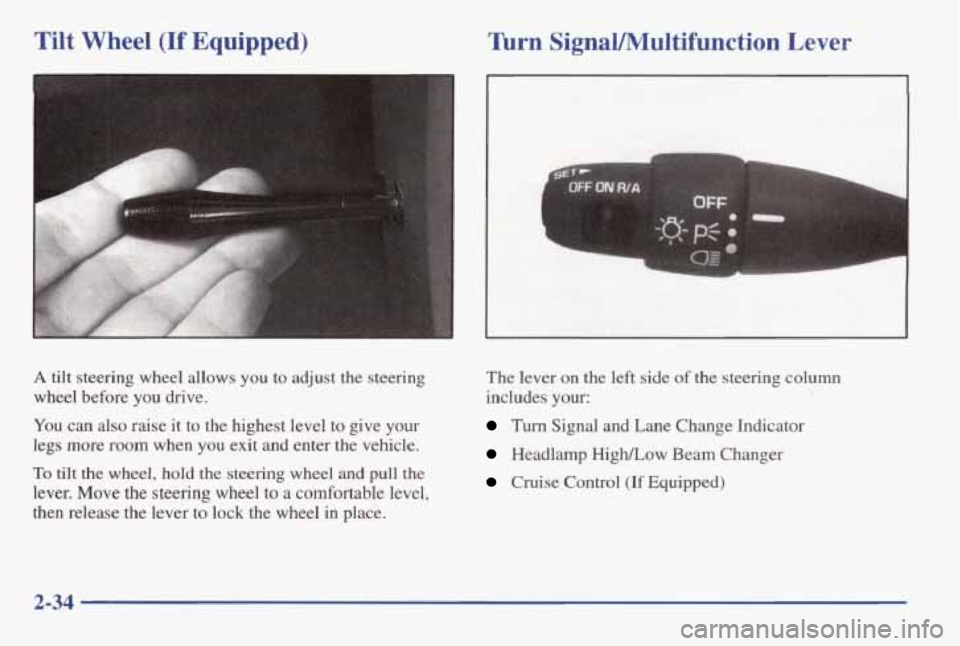
Tilt Wheel (If Equipped) lhrn SignaVMultifunction Lever
A tilt steering wheel allows you to adjust the steering
wheel before you drive.
You can also raise it to the highest level to give your
legs
more room when you exit and enter the vehicle.
To tilt the wheel, hold the steering wheel and pull the
lever. Move the steering wheel to
a comfortable level,
then release the lever
to lock the wheel in place. The lever
on the
left side of the steering column
includes your:
Turn Signal and Lane Change Indicator
Headlamp High/Low Beam Changer
Cruise Control (If Equipped)
2-34
Page 96 of 370
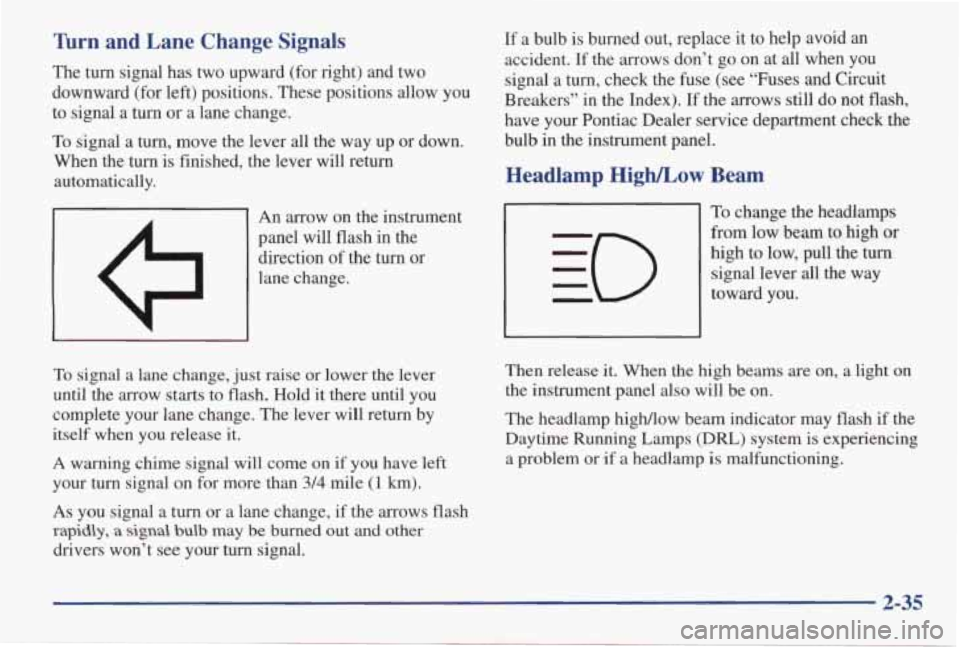
’hrn and Lane Change Signals
The turn signal has two upward (for right) and two
downward (for left) positions. These positions allow you
to signal a turn
or a lane change.
To signal a turn, move the lever all the way up or down.
When the turn is finished, the lever will return
automatically.
An arrow on the instrument
panel will flash in the direction of the turn
or
lane change.
To signal a lane change, just raise or lower the lever
until the arrow starts to flash. Hold
it there until you
complete your lane change. The lever will return by
itself when you release it.
A warning chime signal will come on if you have left
your turn signal on for more than 3/4 mile
(1 km).
As you signal a turn or a lane change, if the arrows flash
rapidly, a signal bulb may be burned out and other
drivers won’t see your turn signal. If
a bulb is burned out, replace it to help avoid an
accident. If the arrows don’t
go on at all when you
signal a turn, check the fuse (see “Fuses
and Circuit
Breakers’’ in the Index).
If the arrows still do not flash,
have your Pontiac Dealer service department check
the
bulb in the instrument panel.
Headlamp Highhow Beam
To change the headlamps
from low beam to high
or
high to low, pull the turn
signal lever all the way
toward
you.
Then release it. When the high beams are on, a light on
the instrument panel also will be on.
The headlamp higMow beam indicator may flash if the
Daytime Running Lamps
(Dm) system is experiencing
a problem or
if a headlamp is malfunctioning.
2-35
Page 103 of 370
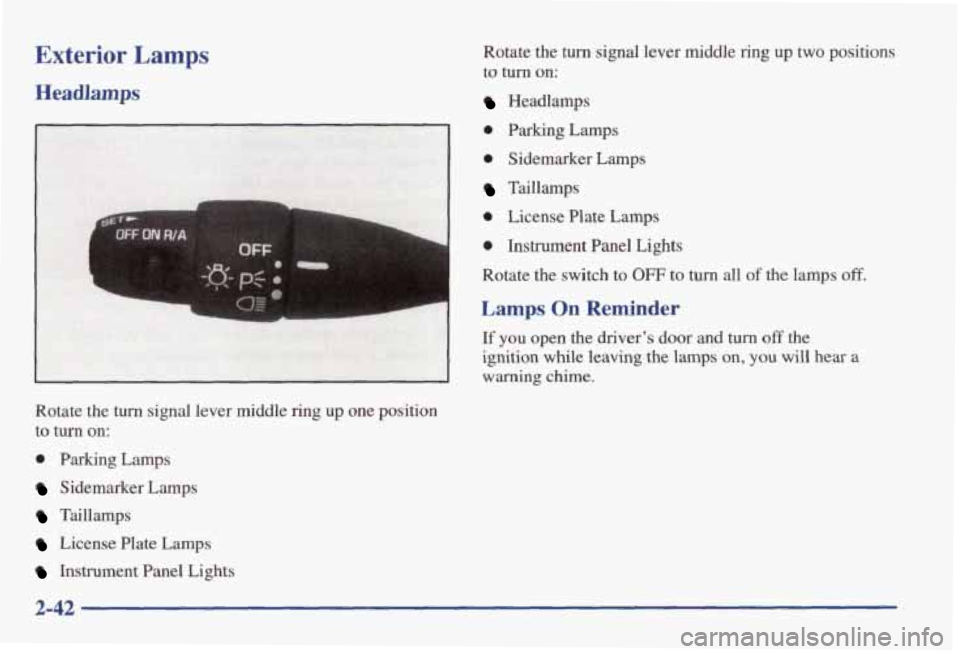
Exterior Lamps
Headlamps
Rotate the turn signal lever middle ring up one position
to
turn on:
0 Parking Lamps
Sidemarker Lamps
Taillamps
License Plate Lamps
Instrument Panel Lights Rotate the
turn signal lever middle ring up two positions
to
turn on:
Headlamps
0 Parking Lamps
0 Sidemarker Lamps
Taillamps
0 License Plate Lamps
0 Instrument Panel Lights
Rotate the switch to OFF to turn all of the lamps off.
Lamps On Reminder
If you open the driver's door and turn off the
ignition while leaving the lamps on, you will hear a
warning chime.
2-42
Page 104 of 370
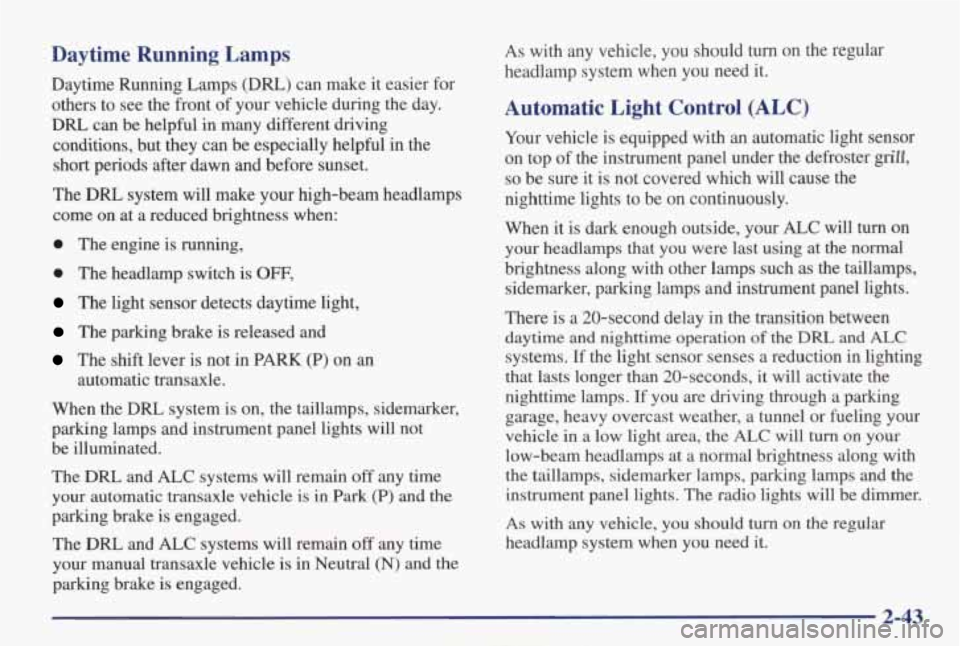
Daytime Running Lamps
Daytime Running Lamps (Dm) can make it easier for
others to see the front of your vehicle during the day.
DRL can be helpful in many different driving
conditions, but they can be especially helpful in the short periods after dawn and before sunset.
The
DRL system will make your high-beam headlamps
come on at a reduced brightness when:
0 The engine is running,
0 The headlamp switch is OFF,
The light sensor detects daytime light,
The parking brake is released and
The shift lever is not in PARK (P) on an
When the DRL system is on, the taillamps, sidemarker,
parking lamps and instrument panel lights will not
be illuminated. automatic transaxle.
The
DIU and ALC systems will remain off any time
your automatic transaxle vehicle is
in Park (P) and the
parking brake is engaged.
The
DFU and ALC systems will remain off any time
your manual transaxle vehicle is in Neutral
(N) and the
parking brake is engaged.
As with any vehicle, you should turn on the regular
headlamp system when you need it.
Automatic Light Control (ALC)
Your vehicle is equipped with an automatic light sensor
on top of the instrument panel under the defroster
grin,
so be sure it is not covered which will cause the
nighttime lights to be on continuously.
When it is dark enough outside,
your ALC will turn on
your headlamps that you were last using at the normal
brightness along with other lamps such as the taillamps,
sidemarker, parking lamps and instrument panel lights.
There is a 20-second delay in the transition between
daytime and nighttime operation
of the DRL and LC
systems. If the light sensor senses a reduction in lighting
that lasts longer than 20-seconds, it will activate the
nighttime lamps. If you are driving through a parking
garage, heavy overcast weather, a tunnel or fueling your
vehicle in a low light area, the
ALC will turn on your
low-beam headlamps at a normal brightness along with
the taillamps, sidemarker lamps, parking lamps and the
instrument panel lights. The radio lights will be dimmer.
As with any vehicle, you should turn on the regular
headlamp system when you need
it.
Page 105 of 370
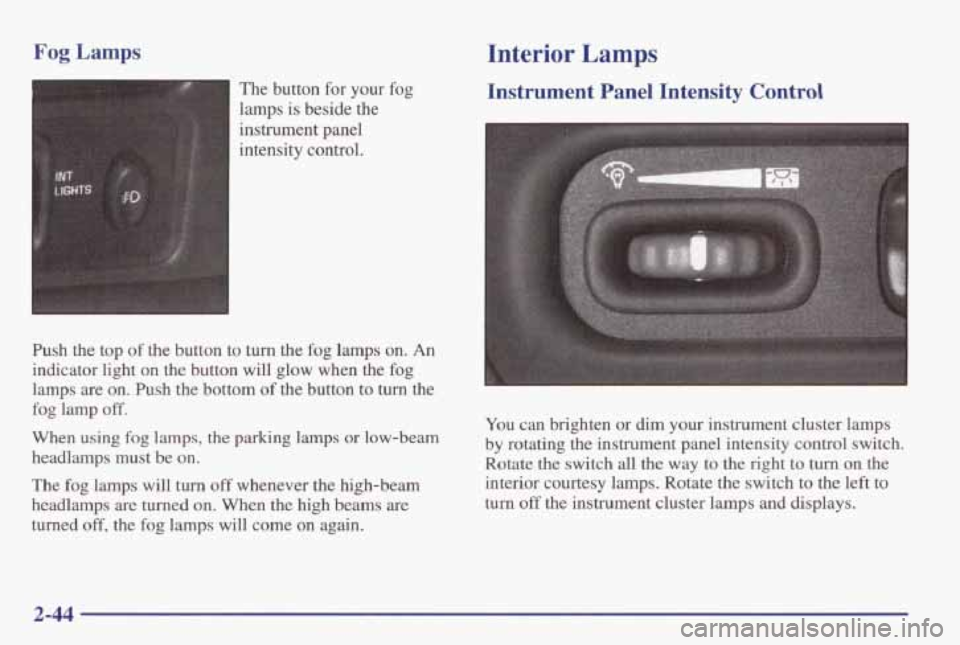
Fog Lamps
The button for your fog
lamps is beside the
instrument panel
intensity control.
Push the top
of the button to turn the fog lamps on. An
indicator light on the button will glow when the fog
lamps are on. Push the bottom of the button to turn the
When using
fog lamps, the parking lamps or low-beam
headlamps must
be on.
fog lamp off.
The fog lamps will turn off whenever the high-beam
headlamps are turned on. When the high beams
are
turned off, the fog lamps will come on again.
Interior Lamps
Instrument Panel Intensity Control
You can brighten or dim your instrument cluster lamps
by rotating the instrument panel intensity control switch.
Rotate the switch
all the way to the right to turn on the
interior courtesy lamps. Rotate the switch to the left to
turn
off the instrument cluster lamps and displays.
2-44
Page 173 of 370
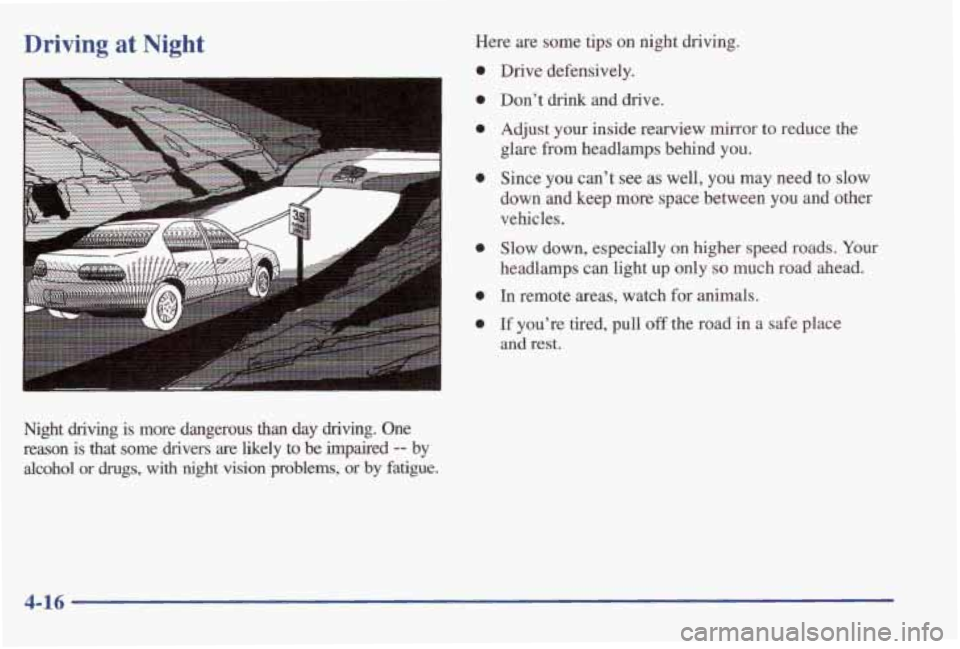
Driving at Night
Night driving is more dangerous than day driving. One
reason is that some drivers are likely to be impaired -- by
alcohol or
drugs, with night vision problems, or by fatigue.
Here are some tips on night driving.
0
0
0
0
0
0
0
Drive defensively.
Don't
drink and drive.
Adjust your inside rearview mirror to reduce the
glare from headlamps behind you.
Since
you can't see as well, you may need to slow
down and keep more space between
you and other
vehicles.
Slow down, especially
on higher speed roads. Your
headlamps can light
up only so much road ahead.
In remote areas, watch for animals.
If you're tired, pull off the road in a safe place
and rest.
4-16
Page 174 of 370
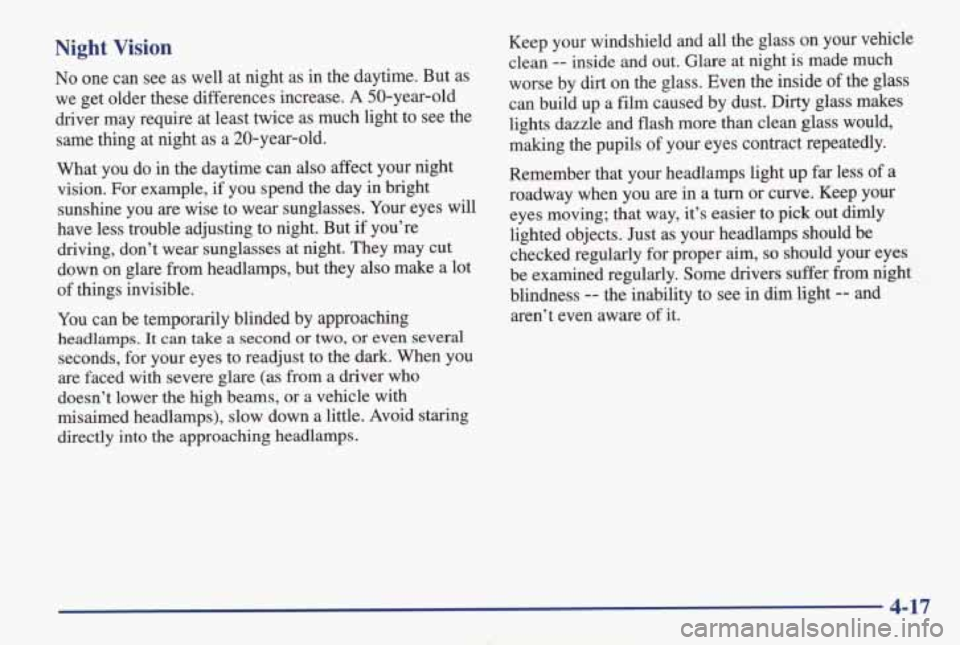
Night Vision
No one can see as well at night as in the daytime. But as
we get older these differences increase.
A 50-year-old
driver may require at least twice as much light to see the same thing at night as
a 20-year-old.
What you
do in the daytime can also affect your night
vision. For example, if you spend the day in bright
sunshine you
are wise to wear sunglasses. Your eyes will
have less trouble adjusting to night. But if you’re
driving, don’t wear sunglasses at night. They may cut
down on glare from headlamps, but they also make
a lot
of things invisible.
You can be temporarily blinded by approaching
headlamps. It can take a second or two, or even several
seconds, for your eyes to readjust to the dark. When you
are faced with severe glare (as from a driver who
doesn’t lower the high beams, or a vehicle with
misaimed headlamps), slow down a little. Avoid staring
directly into
the approaching headlamps. Keep your windshield and
all the glass on your vehicle
clean
-- inside and out. Glare at night is made much
worse by dirt
on the glass. Even the inside of the glass
can build up a film caused by dust. Dirty glass makes
lights dazzle and flash more than clean glass would,
making the pupils
of your eyes contract repeatedly.
Remember that your headlamps light up far less of
a
roadway when you are in a turn or curve. Keep your
eyes moving; that way, it’s easier to pick out dimly
lighted objects. Just as your headlamps should be checked regularly for proper aim,
so should your eyes
be examined regularly. Some drivers suffer from night
blindness
-- the inability to see in dim light -- and
aren’t even aware of it.
4-17
Page 187 of 370
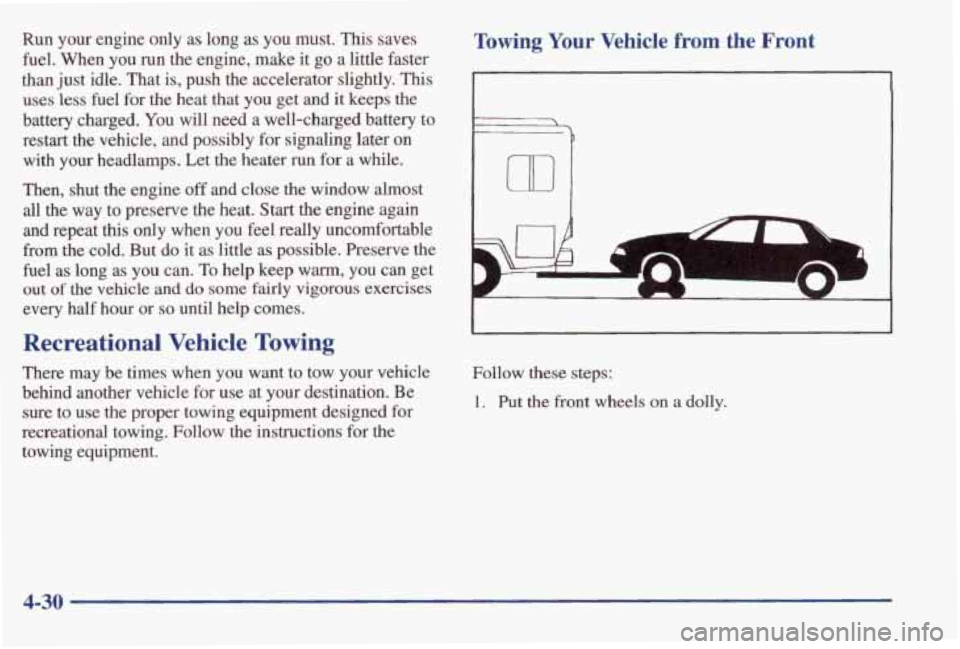
Run your engine only as long as you must. This saves
fuel.
When you run the engine, make it go a little faster
than just idle. That
is, push the accelerator slightly. This
uses less fuel for the heat that you get and it keeps the
battery charged. You will need a well-charged battery to
restart the vehicle, and possibly for signaling later on
with
your headlamps. Let the heater run for a while.
Then, shut the engine
off and close the window almost
all the way
to preserve the heat. Start the engine again
and repeat this only when you feel really uncomfortable
from the cold. But do it as little as possible. Preserve the
fuel
as long as you can. To help keep warm, you can get
out of the vehicle and do some fairly vigorous exercises
every half hour or
so until help comes.
Recreational Vehicle Towing
There may be times when you want to tow your vehicle
behind another vehicle for use at your destination. Be
sure to use the proper towing equipment designed for
recreational towing. Follow the instructions for the
towing equipment.
Towing Your Vehicle from the From
I
Follow these steps:
1. Put the front wheels on a dolly.
4-30
Page 270 of 370
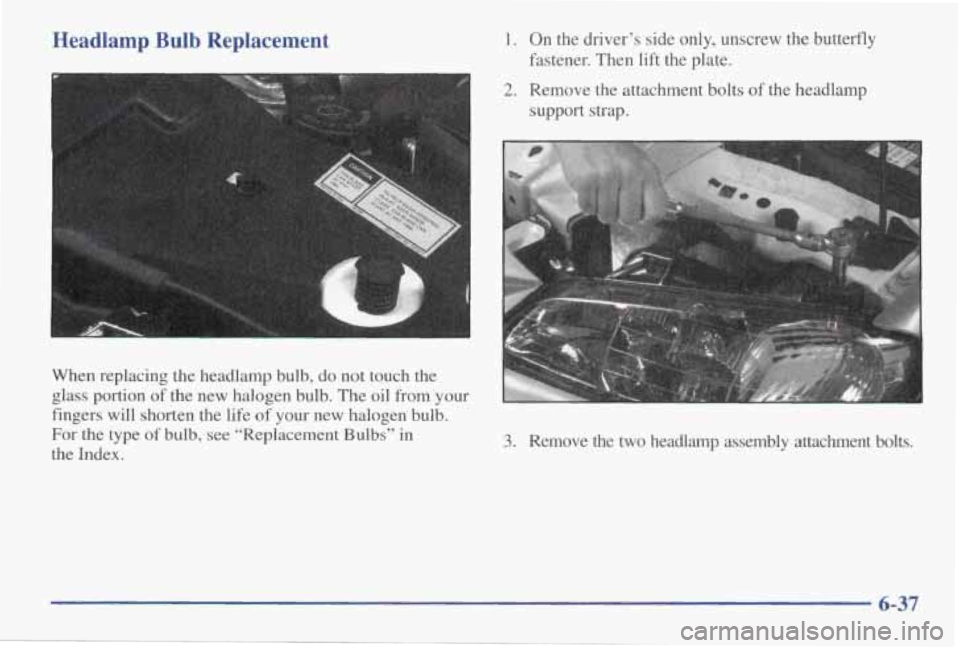
Headlamp Bulb Replacement 1. On the driver’s side only, unscrew the butterfly
fastener. Then lift the plate.
When replacing the headlamp bulb,
do not touch the
glass portion of the new halogen bulb. The oil from your
fingers will shorten the life of your new halogen bulb.
For the type of bulb, see “Replacement Bulbs” in
the Index.
2. Remove the attachment bolts of the headlamp
support strap.
3. Remove the two headlamp assembly attachment bolts.
6-37
Page 271 of 370
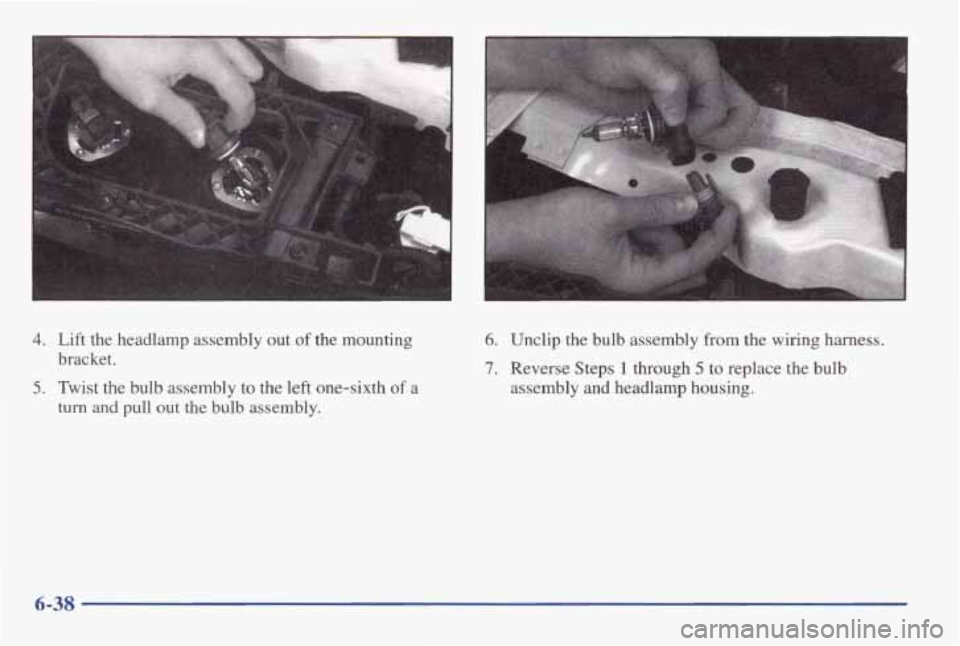
I
I
4. Lift the headlamp assembly out of the mounting
bracket.
5. Twist the bulb assembly to the left one-sixth of a
turn and pull out the bulb assembly.
6. Unclip the bulb assembly from the wiring harness.
7. Reverse Steps 1 through 5 to replace the bulb
assembly and headlamp housing.
6-38